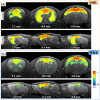Inter-Strain Differences in Default Mode Network: A Resting State fMRI Study on Spontaneously Hypertensive Rat and Wistar Kyoto Rat
- PMID: 26898170
- PMCID: PMC4761976
- DOI: 10.1038/srep21697
Inter-Strain Differences in Default Mode Network: A Resting State fMRI Study on Spontaneously Hypertensive Rat and Wistar Kyoto Rat
Abstract
Genetic divergences among mammalian strains are presented phenotypically in various aspects of physical appearance such as body shape and facial features. Yet how genetic diversity is expressed in brain function still remains unclear. Functional connectivity has been shown to be a valuable approach in characterizing the relationship between brain functions and behaviors. Alterations in the brain default mode network (DMN) have been found in human neuropsychological disorders. In this study we selected the spontaneously hypertensive rat (SHR) and the Wistar Kyoto rat (WKY), two inbred rat strains with close genetic origins, to investigate variations in the DMN. Our results showed that the major DMN differences are the activities in hippocampal area and caudate putamen region. This may be correlated to the hyperactive behavior of the SHR strain. Advanced animal model studies on variations in the DMN may have potential to shed new light on translational medicine, especially with regard to neuropsychological disorders.
Figures




Similar articles
-
Spatial learning/memory and social and nonsocial behaviors in the spontaneously hypertensive, Wistar-Kyoto and Sprague-Dawley rat strains.Pharmacol Biochem Behav. 2004 Mar;77(3):583-94. doi: 10.1016/j.pbb.2003.12.014. Pharmacol Biochem Behav. 2004. PMID: 15006470
-
Resting state default-mode network connectivity in early depression using a seed region-of-interest analysis: decreased connectivity with caudate nucleus.Psychiatry Clin Neurosci. 2009 Dec;63(6):754-61. doi: 10.1111/j.1440-1819.2009.02030.x. Psychiatry Clin Neurosci. 2009. PMID: 20021629
-
Genealogy of the spontaneously hypertensive rat and Wistar-Kyoto rat strains: implications for studies of inherited hypertension.J Cardiovasc Pharmacol. 1990;16 Suppl 7:S1-5. J Cardiovasc Pharmacol. 1990. PMID: 1708002 Review.
-
The nigrostriatal dopamine system and the development of hypertension in the spontaneously hypertensive rat.Arch Mal Coeur Vaiss. 1995 Aug;88(8):1193-6. Arch Mal Coeur Vaiss. 1995. PMID: 8572872
-
Aberrant resting-state functional connectivity in a genetic rat model of depression.Psychiatry Res. 2014 Apr 30;222(1-2):111-3. doi: 10.1016/j.pscychresns.2014.02.001. Epub 2014 Feb 13. Psychiatry Res. 2014. PMID: 24613017
Cited by
-
Mapping and comparing fMRI connectivity networks across species.Commun Biol. 2023 Dec 7;6(1):1238. doi: 10.1038/s42003-023-05629-w. Commun Biol. 2023. PMID: 38062107 Free PMC article. Review.
-
Early structural alterations of intrinsic cardiac ganglionated plexus in spontaneously hypertensive rats.Histol Histopathol. 2022 Oct;37(10):955-970. doi: 10.14670/HH-18-453. Epub 2022 Mar 31. Histol Histopathol. 2022. PMID: 35356999
-
Standardization of Small Animal Imaging-Current Status and Future Prospects.Mol Imaging Biol. 2018 Oct;20(5):716-731. doi: 10.1007/s11307-017-1126-2. Mol Imaging Biol. 2018. PMID: 28971332 Review.
-
Functional Connectivity of the Brain Across Rodents and Humans.Front Neurosci. 2022 Mar 8;16:816331. doi: 10.3389/fnins.2022.816331. eCollection 2022. Front Neurosci. 2022. PMID: 35350561 Free PMC article. Review.
-
Combined rTMS/fMRI Studies: An Overlooked Resource in Animal Models.Front Neurosci. 2018 Mar 23;12:180. doi: 10.3389/fnins.2018.00180. eCollection 2018. Front Neurosci. 2018. PMID: 29628873 Free PMC article. Review.
References
-
- Buckner R. L., Andrews-Hanna J. R. & Schacter D. L. The brain’s default network: anatomy, function, and relevance to disease. Annals of the New York Academy of Sciences 1124, 1–38 (2008). - PubMed
-
- Binder J. R. et al. Conceptual processing during the conscious resting state. A functional MRI study. Journal of Cognitive Neuroscience 11, 80–95 (1999). - PubMed
Publication types
MeSH terms
LinkOut - more resources
Full Text Sources
Other Literature Sources
Medical

